|
|
FUGUE:
CHAPTER V11
THE
MAINTENANCE OF THE ORGAN FROM 1905 TO 1974
AND
ITS INFLUENCE ON THE MUSIC AT ARMLEY
In
1911, on the advice of Dr. (later Sir) A. H. Brewer of Gloucester
Cathedral and Dr. (later Sir) I. A. Atkins of Worcester Cathedral,
the hydraulic blowing plant was replaced by a "Kinetic"
fan blower driven by a 5 h.p. 2-phase electric motor with a long
belt drive, on the grounds of economy in running costs. This gave
good service for 45 years until the renovation of 1956, when first
the electric motor burnt out, and later the fan bearings wore out
and an ominous smell of burning was traced to friction within the
wooden casing of the blower. Fortunately the fire danger was
averted and a new and efficient "Discus" plant was
installed in the blowing chamber at a cost of £369.
The
organ was thoroughly cleaned by Binns in 1921 at a cost of £160,
without any tonal changes, but tuning slides were fitted to all
metal flue pipes for their preservation and the reservoirs and
wind trunking were repaired as necessary. Arising from this work,
Binns wrote to that great admirer and life-long student of
Schulze's work, the Rev. Noel Bonavia-Hunt, expressing his
astonishment at finding all the ranks of the Principal chorus of
the Great Organ to be of the same scale, including the five ranks
of the Mixtur, which is discussed in detail below. This renovation
was carried out at the expense of Mr. H. W. Eyres' daughter,
Viscountess Eyres-Monsell, of Dumbleton Hall, Evesham, Worcs., who
had, on her 21st birthday, given the central tower and spire to
the church, thus completing the exterior of the great
building.
In
1922, the main reservoir in the blowing chamber was replaced and
new wind trunking with
control valves fitted at a cost of £105.
Thomas
Cawthra died in 1921 and was succeeded by Thomas E. Pearson,
Mus.D., F.R.C.O., as organist for three years, who wrote a
critical article on the Schulze organ in the quarterly journal
"The Organ," discussed in Chapter IX. James Jepson
Binns, who had so conscientiously maintained the organ, died in
1929 and the maintenance passed into the hands of his successors,
Messrs. Binns, Fitton & Haley.
Dr.
Pearson was followed in 1924 by the Glaswegian Herbert Bardgett,
Mus.B., F.R.C.O., as organist and choirmaster. Formerly organist
of All Souls' Church (Hook Memorial) Leeds and assistant organist
at Leeds Parish Church, he found in the Vicar, the Rev. H. Lovell
Clarke, one who appreciated the potential of the genius of Schulze
and, with his great musical talent, Bardgett was able to build
around the organ a wonderful musical atmosphere which brought
inspiration and help to the many who joined in the worship at St.
Bartholomew's. Soon to become famous as conductor, adjudicator,
lecturer, choir trainer, organist and teacher, Bardgett left
behind him a musical heritage in a fine library of church music,
most of which is no longer in usable condition, and in the
memories of many concerts and recitals in the great church. He
followed a policy that enriched the musical life of Leeds, notably
in the performances of Bach's "St. John Passion" at
Armley in Passiontide and of Bach's "Christmas Oratorio"
with the New Choral Society, instead of Handel's "Messiah."
His notable contribution to the art of music was recognised in
1951 when he received the Order of the British Empire.
 Herbert
Bardget
Herbert
Bardget
|
|
Dr.
Pearson was followed in 1924 by the Glaswegian Herbert
Bardgett, Mus.B., F.R.C.O., as organist and choirmaster.
Formerly organist of All Souls' Church (Hook Memorial) Leeds
and assistant organist at Leeds Parish Church, he found in the
Vicar, the Rev. H. Lovell Clarke, one who appreciated the
potential of the genius of Schulze and, with his great musical
talent, Bardgett was able to build around the organ a wonderful
musical atmosphere which brought inspiration and help to the
many who joined in the worship at St. Bartholomew's. Soon to
become famous as conductor, adjudicator, lecturer, choir
trainer, organist and teacher, Bardgett left behind him a
musical heritage in a fine library of church music, most of
which is no longer in usable condition, and in the memories
of many concerts and recitals in the great church. He followed
a policy that enriched the musical life of Leeds, notably in
the performances of Bach's "St. John Passion" at
Armley in Passiontide and of Bach's "Christmas Oratorio"
with the New Choral Society, instead of Handel's "Messiah."
His notable contribution to the art of music was recognised in
1951 when he received the Order of the British Empire.
In
1962, Herbert Bardgett came back to Armley, with the Leeds
Philharmonic, to record “The Crucifixion” by
Stainer. Mr. Bardgett told us that he was realizing a
long-cherished dream, and the resulting L.P. was successful,
and certainly helped to spread the word of St. Bartholomew’s
musical splendours.
|
|
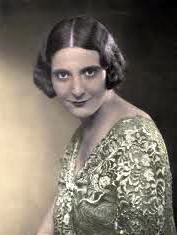
|
Amongst
those associated with the music in Bardgett's day, two names
stand out clearly.
Elsie Suddaby, 1893-1980,
(left), lived at No. 39 Wesley Road, only a few hundred
yards from the church in which her beautiful clear soprano
voice was often heard, both as a member of the congregation and
in recitals and concerts arranged by Bardgett. She became one
of Britain's leading sopranos, but was always ready to sing in
St. Bartholomew's to the accompaniments played on the organ.
|
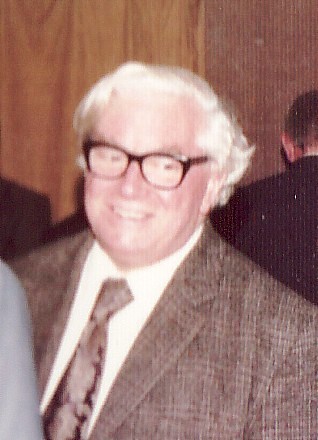
|
Douglas
Robinson, 1912-1984, (left), began his musical
career as a chorister under Bardgett, who was by that time
accompanist to the Leeds Musical Festival and conductor of the
famous Huddersfield Choral Society. At an early age he
showed great promise as a conductor, becoming Chorus Master at
the Royal Opera House, Covent Garden, from 1946 to 1974 and in
1972 Chorus Master of the Huddersfield Choral Society. In 1973
he was appointed Associate Conductor of that choral society - a
wonderful tribute to the teaching and inspiration of his early
training under Bardgett.
|
The
atmospheric pollution in the vicinity of St. Bartholomew's was a
serious menace to the organ at the close of the nineteenth and for
the first half of the twentieth century. During Herbert Bardgett's
tenure of the post of organist, Messrs. Binns, Fitton & Haley
wrote to him in 1930 as follows:
-
The
quotation of £140 for this work, which included the
cleaning of the case and front pipes, was accepted by the
Parochial Church Council in June, 1932, but an additional
quotation of £25 for the revoicing of all the chorus
reeds, as suggested by the builders, was fortunately not
accepted.
The programme of a recital given by
Leslie A. Walsh, assisted by Reginald Walsh, tenor, on 6th
December, 1931, is typical of the music performed in St.
Bartholomew's during Bardgett's tenure of the organist's post.
|
|
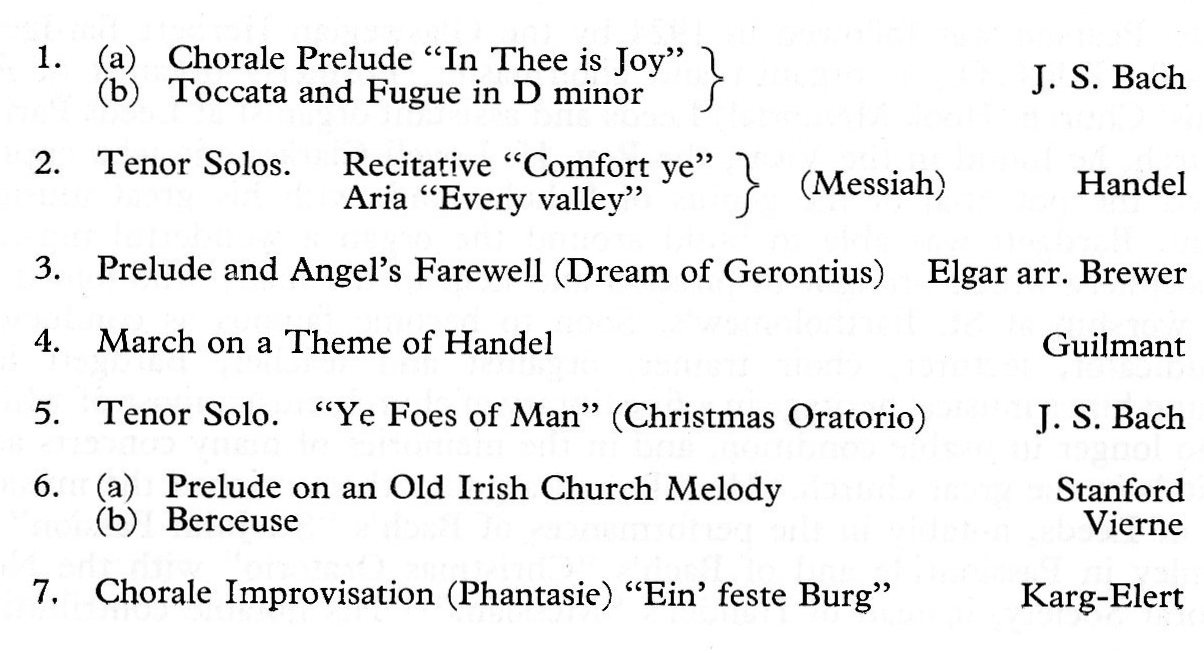
|
|
|
The
Renovation of 1956
As
early as 1922 Dr. Pearson found the tubular-pneumatic action to be
noisy, the thumb pistons to be too far apart and the pedalboard to
be incorrectly placed relative to the manuals. The
piston action was repaired by Messrs. Binns, Fitton & Haley in
1946, and in 1954 the tuning and maintenance passed into the hands
of Mr. John T. Jackson of Leeds, on behalf of Messrs. Hill &
Son and Norman & Beard.
|
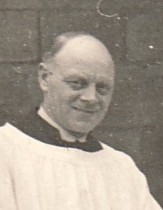
|
Mr.
W. Iles Pulford, (left), organist of St.
Bartholomew's from 1940 to 1953, was responsible c.1948 for the
initiation of a scheme for renovation of the organ. Originally
this ambitious project included cleaning, conversion to
electro-pneumatic action and the provision of a new detached
console in the south choir stalls, to enable the organist both
to hear the instrument better as a whole and to be in closer
contact with the choir. However it was quite beyond the
resources of the parish of Armley to raise the sum of £2,000
required, since it no longer included the former wealthy
members, and a wider appeal was therefore launched.
The
Rev. Noel Bonavia-Hunt of Stagsden, Bedford, well known as a
life-long admirer of Schulze's work, appealed for support
through the columns of "The Times" on 16th March,
1950. However, even with a generous donation of £100 from
Viscountess Eyres-Monsell it was only with great
difficulty that about £1,000 was available for the
renovation, and conversion to electro-pneumatic action was out
of the question. This was probably just as well since, as
pointed out by Mr. Walter Hartley, organist of Selby Abbey, who
offered to act as technical adviser to the Organ Committee,
electro-pneumatic action with a new console by a first-rate
firm would have been far more costly than was realised.
|
The
organization of the appeal for which Mr. Iles Pulford had worked
so hard was continued in 1953 by his successor Mr. Alan A. Tranah
and the restoration was carried out in 1956 during the
organistship of Mr. J. J. F. Watkins, who not only wrote the
historical brochure for the occasion, but supervised the cleaning
of the instrument, blowing chamber and case.
Tenders
were received from three firms approached, that of Messrs. William
Hill & Son and Norman & Beard for £979 being
accepted. Mr. Herbert Norman, reporting on the state of the organ,
emphasized that only a thorough dismantling and cleaning, with
renovation of the Binns pneumatic actions and the wind trunks,
would render the instrument playable for the services of the
church for one or possibly two decades, owing to the great
accumulation of dirt over many years.
The
condition of the reed stops was criticised by all three
organ-builders who tendered for the restoration. The resonators of
the Schulze reeds are neither mitred nor hooded and the reeds are
therefore very subject to the ill effects of dust. In addition,
the resonators are not provided with the regulator tongues now
always fitted to assist in the regulation and tuning of individual
notes. (As may be seen, see left,
certain resonators of the Great
Organ reeds have been cut to form regular tongues. This is
probably the work of later organ-builders or tuners.)
It
was therefore suggested by Messrs. Hill & Son and Norman &
Beard that the Swell Organ chorus reeds should be modified by
lengthening the resonators with the addition of regulator tongues,
that the Trompete 8ft. of the Great Organ should also be hooded,
and that linen dust covers should be fitted to the Tuba 16ft. and
to both Pedal Organ reed stops, at an additional cost of £332.

|
The
C sharp side of the Great Organ 5 rank Mixtur.
Behind, to
the left, are the 16ft. Tuba and the 8ft. Trompete
resonators
which have been cut to form tongues for tuning
these reed stops.
|
|
Noel
Bonavia-Hunt wrote in April, 1954, to Mr. Tranah as follows:
In
the event, the reeds were regulated, but not modified in any
way – a decision evidently taken by the Parish Church
Council on the grounds of expense, since the possibility of
undertaking this work at a later date is mentioned in the
correspondence.
|
Thus
for the second time the reed stops narrowly escaped modification
and remain as Schulze left them, with the exception of the
weighted reed basses which, as mentioned previously, are thought
to have been the work of J. J. Binns. Mr. Watkins was unable to
trace the lost Rohrflöte pipes which had been displaced by
the Celeste rank many years before. During the renovation the
greatest care was taken to preserve the tone of the Schulze
pipes.
The opening recital was
given in the presence of an audience of about 500, including many
Schulze lovers, on 10th March, 1956, by Francis Jackson, Organist
and Master of the Choristers of York Minster - a very fitting
choice since Tertius T. Noble, then Organist of York Minster, was
the recitalist after the 1905 rebuild.
|

|
|
The
organ had been fine-tuned on the previous afternoon, but sudden
fluctuations in temperature, aggravated by the presence of a large
audience, had the inevitable adverse effect on the tuning,
especially of the reeds, but worse was to follow! Francis Jackson
had completed his balance tests during the afternoon of the day of
the recital, when all was well, but one of the B.B.C. engineers
later disobeyed instructions and, on his own initiative, climbed
above the Great Organ soundboard to fix an additional microphone
sling. He got into difficulties however and was rescued by Mr.
Watkins when he returned to the church with the recitalist,
shortly before the recital was to commence. Unfortunately in his
haste, the engineer trod on and dislodged a large dust board,
which crashed on to the pipes on the C sharp side of the Great
Octave and Rausch Quinte, damaging nine pipes seriously and
disturbing the tuning of many more.
Right:
Francis Jackson
|
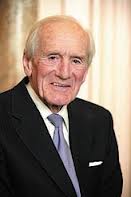
|
|

|
Left:
John Watkins
|
The
extent of the damage was not realised until the first chords of
the Bach Prelude in D major crashed out and the recital was being
broadcast! The cacophony was such that several local organists in
the audience left the church after the first item had been played.
One wrote to "Musical Opinion" as follows:
‘Of
what interest, musically, are these “historic”
instruments? Even the most uncritical ear must have been shocked
by the terrible discrepancies in the tuning of the mutation stops
of this organ . . .’
His
unjust criticism was rebuked by Mr. Watkins in a subsequent letter
to "Musical Opinion." Had he remained for the rest of
the programme, he would have heard the explanation of the
unfortunate occurrence from Mr. Herbert Norman, of Hill & Son
and Norman & Beard, who later came down from the organ loft
and addressed the audience. Francis Jackson went bravely through
the advertised programme, which included his own Toccata, Chorale
and Fugue, but the disappointment felt by the organist (Mr. J. J.
F. Watkins),
Mr. Herbert Norman and all who had worked so
long for the renovation of the organ, was great indeed.
The
nine seriously damaged pipes were replaced by others carefully
matched for tonal quality and the less seriously damaged were
repaired by Mr. Jackson the organ-builder.
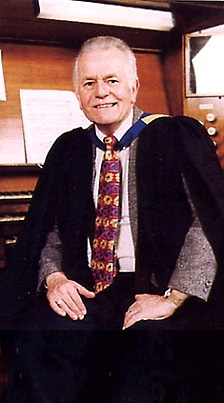
|
The
organ then entered upon a fresh period of service in the
worship of the church and in the excellent series of recitals
established by Mr. Anthony Norcliffe, (left),
organist 1966-1973, and carried on by Mr. Arnold Mahon,
(right) organist 1973-1986, who was born in
Armley.
Re-leathering
of the pneumatic motors of the organ action was carried out in
stages, those of the Choir Organ in 1959, of the Great Organ in
1960 (at a cost of £74) and of the Swell Organ in 1962
(at a cost of £100). This work was done by Mr. J. T.
Jackson on behalf of Messrs. Hill & Son and Norman &
Beard.
Having
fortunately survived the fire danger due to failure of the
“Kinetic” electric blower in 1956, another model of
which was responsible for the destruction of Norwich Cathedral
organ in 1938, the Armley Schulze underwent another trial in
1964 - this time by water!
|
|

|
Early
in 1964 the interior masonry of the church was thoroughly cleaned
by a steam process, but unfortunately the contractors failed to
appreciate the importance of following the measures detailed by
Mr. Jackson for the preservation of the organ. The instrument was
only partially protected by waterproof sheeting, and steam was
used to clean the north arch of the crossing, above the organ,
instead of a dry cleaning process as specified. The result was a
severe wetting of the instrument by condensation or by water
spray, with disastrous consequences to the action and some
soundboards.
Water ran down the sheeting
to the console with the result that the ivories of the Great Organ
keys were loosened, drawstop rods swelled and became inoperable,
several stops were silent because of swelling and distortion of
soundboard sliders and the leatherwork of the reservoirs was
seriously affected by the excessive humidity. Extensive rusting
took place, affecting the tuning slides of Great and Choir Organs
and even splitting the ivory piston heads carried on steel
wires.
Henry
Willis IV was called in to assess the damage for insurance
purposes and, on his advice, Mr. Jackson inserted electric fan
heaters at strategic points within the organ which he visited
daily for several weeks, using an hygrometer to record the
humidity. It was greatly due to his devoted work that the
instrument was saved. Extensive repairs were necessary to the
Great and Pedal soundboards, new tuning slides were provided for
the metal pipes of Great and Choir Organs, the tongues and
shallots of the Great and Pedal reed stops were cleaned and the
large four-manual console was dismantled and repaired, the Great
keys being returned to the keymakers for restoration. The
leatherwork was treated with oil to combat the effects of
excessive moisture.
The
cost of the immediate repairs carried out by Mr. Jackson, on
behalf of Messrs. Hill & Son and Norman & Beard, was £935.
To offset the cost of future repairs to the leatherwork of the
action, which it was realised would inevitably arise later as a
result of the excessive humidity, a sum of £500 was set
aside. This heavy expenditure was met by insurance after lengthy
discussions, terminating in 1966. In 1967, the pneumatic motors of
two of the four Pedal Organ soundboards were re-leathered at a
cost of £210, and, in 1972 when the effects of inflation
were being felt, the pipes of Choir and Echo Organs, which were
very dirty, were cleaned at a cost of £359.
|
|
|

